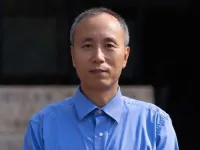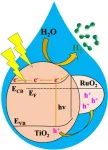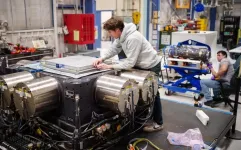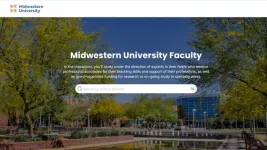(Press-News.org) PHILADELPHIA – There are many important reasons for keeping cuts and sores clean, but new research from the Perelman School of Medicine at the University of Pennsylvania shows that a certain bug, Alcaligenes faecalis (A. faecalis), can facilitate healing of hard-to-treat wounds among people with diabetes. While there are many studies done on potentially harmful bacteria in wounds, the researchers discovered that A. faecalis, a bacterium found in many types of chronic wounds, actually boosts healing of diabetic wounds. The researchers found that the beneficial bacterium can promote skin cell movements that are essential for wound closure by inhibiting enzymes that are over-produced in people with diabetes. The findings are published in Science Advances, led by Penn’s Elizabeth Grice, PhD, the Sandra J. Lazarus Professor in Dermatology, and Ellen K. White, an MD-PhD student at Penn.
The team says that uncovering the mechanisms behind how A. faecalis boosts healing could help scientists find new treatments for diabetic wounds.
“This research builds heavily on our previous research where we profiled the bacteria found in diabetic foot ulcers over time and studied how these bacteria influence healing outcomes,” said Dr. Grice. “We did not expect to find that a bacterium would be able to promote healing, but this surprising finding motivated further studies of A. faecalis.”
Chronic wounds, categorized by sores, ulcers, or lacerations that fail to heal or heal very slowly, are common in patients with diabetes. They can be painful, make individuals susceptible to further infection, and are linked to higher rates of morbidity and mortality. New therapies are needed to treat these debilitating wounds, but there have not been many new treatment developments which include surgical removal of dead tissue and bandaging.
To understand how A. faecalis influenced diabetic healing, the researchers did several types of tests with diabetic mice, their skin cells, and human diabetic skin samples. First, they found that using A. faecalis to inoculate diabetic mice, which have wound healing defects, led to accelerated wound healing with no signs of infection. Next, they learned introducing A. faecalis to wounds caused keratinocytes, the dominant wound healing cell type in the epidermis, to proliferate and migrate to close the wound more than the untreated cells. Additionally, skin samples taken from individuals who have diabetes were cultured with A. faecalis, and after 10 days, the samples with the bacterium had a statistically significant greater outgrowth of keratinocytes.
From there, the researchers saw mice diabetic wounds treated with A. faecalis turned up genes linked to the activation of leukocytes including T cells which are vital in the immune system’s defense. It also downregulated genes responsible for collagen breakdown, specifically enzymes called matrix metalloproteinases (MMPs). Importantly, there are too many MMPs in people with diabetes and have been shown to inhibit proper wound healing. The study focused particularly on MMP-10 which is expressed by keratinocytes, and was lowered in wounds treated with A. faecalis.
“MMPs are necessary enzymes that break down connections between cells to allow cells to move. But in patients with diabetes, MMPs are known to exist at much higher levels,” White said. “Our findings show that A. faecalis rebalances the MMP expression in wounds, which allows faster wound closure. In future studies we hope to learn more about how the bacteria communicates with skin cells, and also how A. faecalis interacts with other bacteria in the wound.”
This new research exposes areas where scientists can explore potential therapeutics. By not only focusing on the microbes involved in the chronic wound and healing process, but also on their specific interactions, scientists could try to develop more options for wound care.
“Bacterial-based wound therapies are an exciting new frontier,” said Grice. “There are many different ways to take advantage of our findings and future work on the wound microbiome. It may be possible to isolate the pro-healing molecules secreted by A. faecalis or target the pathways that are downstream of the bacteria’s effects. The better we understand the whole process, the more likely we can translate our findings to ultimately help patients with wound and skin repair problems.”
This research was supported by the NIH Institute of Nursing Research (R01NR009448, R01NR015639), National Institute of Arthritis and Musculoskeletal and Skin Diseases (P30AR069589, F31AR079852, T32AR007465, K99AR081404, F31AR079845), Prevent Cancer Foundation, Penn SBDRC Pilo and Feasibility Grant (P30AR069589), Penn Blavatnik Family Fellowship, NIH National Institute of Allergy and Infectious Diseases (5T32AI141393), and the NIH National Institute of General Medical Sciences (R25GM071745-19).
END
Penn researchers reveal how a bacterium supports healing of chronic diabetic wounds
The findings could be used to develop topical or bacterial-based treatments for patients with wounds that do not heal well on their own
2024-07-25
ELSE PRESS RELEASES FROM THIS DATE:
A recipe for zero-emissions fuel: Soda cans, seawater, and caffeine
2024-07-25
A sustainable source for clean energy may lie in old soda cans and seawater.
MIT engineers have found that when the aluminum in soda cans is exposed in its pure form and mixed with seawater, the solution bubbles up and naturally produces hydrogen — a gas that can be subsequently used to power an engine or fuel cell without generating carbon emissions. What’s more, this simple reaction can be sped up by adding a common stimulant: caffeine.
In a study appearing today in the journal Cell Reports Physical Science, the researchers show they can produce hydrogen gas by dropping pretreated, pebble-sized aluminum pellets into a beaker ...
Study suggests preoperative iron infusions work better than blood transfusions for some anemic patients
2024-07-25
In a rigorous medical records study covering tens of thousands of patients, Johns Hopkins Medicine researchers conclude that some patients with preoperative anemia have better outcomes if they get iron infusions before surgery rather than standard red blood cell transfusions.
The findings, published July 22 in Anesthesia & Analgesia, contribute to mounting evidence that such iron infusions, which boost the production of a person’s own red blood cells, are better than relying on someone else’s blood.
“Anemia ...
UH engineer develops technique that enhances thermal imaging and infrared thermography for police, medical, military use
2024-07-25
A new method to measure the continuous spectrum of light, developed in the lab of University of Houston professor of electrical and computer engineering Jiming Bao, is set to improve thermal imaging and infrared thermography, techniques used to measure and visualize temperature distributions without direct contact with the subject being photographed.
Because they are highly sensitive, thermal cameras and infrared thermometers measure temperature accurately from a distance, making them versatile and valuable tools in many fields from the military to medical diagnostics. They detect infrared radiation, ...
Cancer drug could ease cognitive function for some with autism
2024-07-25
An experimental cancer drug could make thinking easier for individuals with Rett syndrome, a rare disorder linked to autism, according to new research from the University of California San Diego — a discovery that could lead to therapies for patients with other neurological conditions.
The findings, published July 25 in Stem Cell Reports, highlight the role of microglia — a type of white blood cell found in the central nervous system — in the formation of the human brain.
While such cells have been better studied in neurodegenerative disorders like Alzheimer’s disease, amyotrophic ...
Oregon State University research uncovers better way to produce green hydrogen
2024-07-25
CORVALLIS, Ore. – Researchers at Oregon State University have developed a material that shows a remarkable ability to convert sunlight and water into clean energy.
A collaboration led by Kyriakos Stylianou of the OSU College of Science created a photocatalyst that enables the high-speed, high-efficiency production of hydrogen, used in fuel cells for cars as well as in the manufacture of many chemicals including ammonia, in the refining of metals and in making plastics.
The findings represent a potential new tool to use against greenhouse gas emissions and climate change, said Stylianou, whose research focuses ...
Transforming environmental testing one shake at a time
2024-07-25
ALBUQUERQUE, N.M. — Testing weapons and components in a lab-controlled environment has always been at the center of Sandia National Laboratories’ mission. Since the U.S. stopped underground explosives tests on weapons in the early 1990s, Sandia has developed other methods to conduct experiments that mimic the range of environments a weapons unit might experience. A newly developed method is getting better results, with fewer tests, in less time.
“Our job in the laboratory is to simulate the environment and lifetime of stress ...
Midwestern launches public research profiles through Symplectic Elements
2024-07-25
Digital Science, a technology company serving stakeholders across the research ecosystem, is pleased to share the news that Midwestern University has successfully launched a new faculty profiles portal powered by Symplectic Elements.
Midwestern has been utilizing Symplectic Elements as its Research Information Management System since 2019, and has made the decision to expand its use by adding public profiles. The faculty profiles repurpose the comprehensive data already within Elements to populate enhanced profiles, including biographical information as ...
Accelerating motor neurone disease research by harnessing the power of health data
2024-07-25
MND is a devastating disease affecting the motor neurones in the brain and spinal cord, leading to progressive muscle weakness and paralysis. Despite decades of research, several scientific challenges continue to impede the development of effective therapies for the thousands of people living with MND in the UK.
The MND Research Data Catalyst is a new initiative led by HDR UK and DPUK, with the UK Dementia Research Institute (UK DRI) and in partnership with the MND research community, to accelerate the discovery of new diagnostics, treatments and support better care for MND patients. This will be achieved by harnessing the UK’s trustworthy, large-scale health ...
World Hepatitis Day 2024: Madrid study shows decrease in active hepatitis C infection among risk groups, indicating effectiveness of public health measures
2024-07-25
A study conducted through a mobile screening unit in Madrid, Spain from 2017 to 2023 and published in Eurosurveillance found that active hepatitis C virus (HCV) infection decreased from 23% to 6% in that period among people who use drugs (PWUD) that visited the unit. The study found that the use of intravenous drugs was the most significant risk factor for infection among PWUD. It confirmed that HCV screening and treatment programmes targeting this at-risk population are effective and can help achieve the World Health Organization goal of HCV elimination as public health threat by 2030.
Study participants and methods
Participants were recruited in ‘hotspots’ ...
After Trump’s election, women of color had more underweight, premature babies, study finds
2024-07-25
In 2016, President-elect Donald Trump vowed to deport thousands of immigrants. His anti-immigration message vilified foreign-born people living in the U.S. as criminals and rapists. Besides making good on many harsh, immigration-related promises, the years after his election stoked the anxieties of millions of people.
Now, with Trump once again in contention for the White House, a new study from the University of California, Berkeley, reveals the surprising — and potentially lifelong — association between those early Trump years and the health of society's newest citizens.
In ...
LAST 30 PRESS RELEASES:
Mosquitoes’ thirst for human blood has increased as biodiversity loss worsens
The stop-smoking medication varenicline may also work for cannabis use disorder
Potential new treatment for sepsis
Study reveals how many hours of video games per week might be too many
Electrospinning for mimicking bioelectric microenvironment in tissue regeneration
Home fingertip oxygen monitors less accurate for people with darker skin tones
Six weeks in a cast no less effective than surgery for unstable ankle fractures
Precautionary approach to alcohol-free and low alcohol drinks needed to protect public health, say experts
Gas-atomized Ca–Mg alloy powders produce hydrogen simply by adding water — high-efficiency hydrogen generation at room temperature
British redcoat’s lost memoir reveals harsh realities of life as a disabled veteran
World-leading rare earth magnet recycling facility launches in UK
Corday Selden selected for the Oceanography Society Early Career Award
MIT chemists determine the structure of the fuzzy coat that surrounds Tau proteins
Same moves, different terrain: How bacteria navigate complex environments without changing their playbook
Severe weather is deadly for vulnerable older adults long after the storm ends, study finds
Expert panel highlights opportunities for improving cancer studies
Hearing aid prescriptions not associated with changes in memory and thinking
Seth Zippel selected for The Oceanography Society Early Career Award
Jeremy Horowitz selected for The Oceanography Society Early Career Award
Kennesaw State University’s Jerry Mack named Paul “Bear” Bryant Newcomer Coach of the Year
Ancient teeth are treasure troves of data on Iron Age lifestyles
Avocados may become easier to grow in India—but not if global emissions remain high
Pregnant women with IBD show heightened inflammation in vaginal mucosa
Underwater photos show seabirds, seals and fish interacting with a tidal turbine in Washington State
1 in 5 surveyed UK adults who have experienced the death of a pet report it as more distressing than experienced human deaths, with significant rates of prolonged grief disorder symptoms also being re
Polyester microfibers in soil negatively impact the development of cherry tomato plants in experiments, raising concerns over the potential effect of high levels of such contaminants
LGBTQ+ adults may be around twice as likely to be unemployed or to report workforce non-participation compared to heterosexual adults, per large representative Australian survey
Horses can smell fear: In experiments where horses smelled sweat from scared humans, they reacted to scary and sudden events with increased fear and reduced human interaction
New synaptic formation in adolescence challenges conventional views of brain development
Scientists identify target to treat devastating brain disease
[Press-News.org] Penn researchers reveal how a bacterium supports healing of chronic diabetic woundsThe findings could be used to develop topical or bacterial-based treatments for patients with wounds that do not heal well on their own






